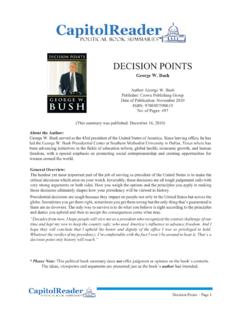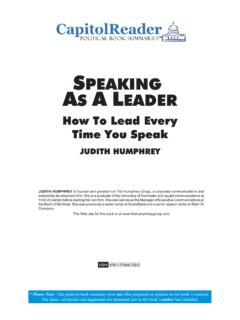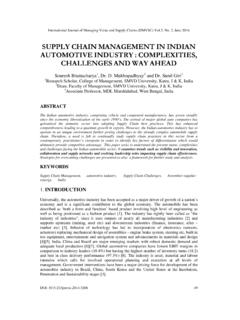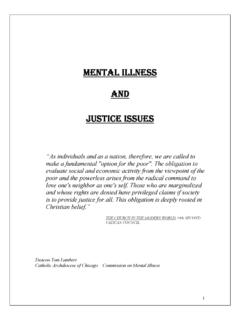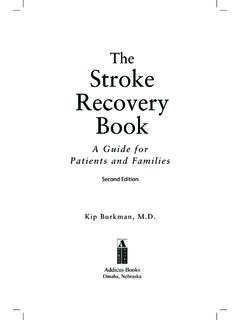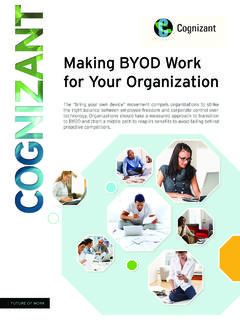Transcription of The Checklist Manifesto - CapitolReader.Com
1 A concentrated business information service. Every week, subscribers are e-mailed aconcise summary of a different business book. Each summary is about 8 pages long and contains thestripped-down essential ideas from the entire book in a time-saving format. By investing less than one hourper week in these summaries, subscribers gain a working knowledge of the top business titles. Subscriptionsare available on a monthly or yearly basis. Further information is available at to Get Things RightATUL GAWANDEATUL GAWANDEis a general surgeon in Boston, a staff writer forThe New Yorkerand an assistant professorat Harvard Medical School and the Harvard School of Public Health. He has written two other books,Better: ASurgeon s Notes on PerformanceandComplications: A Surgeon s Notes on an Imperfect Web site for this book is at Checklist Manifesto - Page 1 MAIN IDEAIn complex situations such as those which arise in almost every profession and industry today the solutions to problems aretechnical and demanding.
2 There are often a variety of different ways to solve a problem. It s all too easy to get so caught up dealingwith all these complexities that the most obvious and common sense immediate solutions are not tried first. To overcome thisproblem, take a leaf from the commercial aviation industry and develop checklists people can use to make sure every base is coveredquickly and concisely. Checklists are a forgotten or ignored business tool. It s time for them to come in from the cold. Here, then, is our situation at the start of the twenty-first century: We have accumulated stupendous know-how. We have put it in thehands of some of the most highly trained, highly skilled, and hardworking people in our society. And with it, they have accomplishedextraordinary things. Nonetheless, that know-how is often unmanageable. Avoidable failures are common and persistent, not tomention demoralizing and frustrating, across many fields from medicine to finance, business to government.
3 And the reason isincreasingly evident: the volume and complexity of what we know has exceeded our individual ability to deliver its benefits correctly,safely, or reliably. Knowledge has both saved us and burdened us. That means we need a different strategy for overcoming failure,one that builds on experience and takes advantage of the knowledge people have but somehow also makes up for our humaninadequacies. And there is such a strategy though it will seem almost ridiculous in its simplicity, maybe even crazy to those of uswho have spent years carefully developing ever more advanced skills and technologies. It is a Checklist . Atul GawandeThe medical care is a good example of how professional fields of expertise have developed in recentyears with the coming of the information revolution. Today s medical practitioners are extremely educatedand superbly experienced in their areas of expertise, but that increase in specialization is bringing aboutsome unintended consequences.
4 Everyone is getting so busy in their respective areas of expertise somebasic and preventable patients deaths are industries today have entered what could be termed their own B-17 phases . Large and growingchunks of what software designers, financial managers, firefighters, police officers and doctors do are nowmuch too complex to be carried out from memory alone. The solution is to follow commercial aviation slead and integrate the more systematic use of checklists into day-to-day may seem like a ridiculously simple concept in a complex world but the evidence is they checklists get the routine and obvious tasks out of your mind so you can instead focus on the hardstuff. They have been shown to work in venture capital investment just as effectively as they work incommercial aviation and medicine. Chances are they will work their magic in every industry imaginable and will work even better in the future as everything gets progressively more complex.
5 KnowledgeExperienceExtremecomplexityand specializationDevelop checklists andthen consistently useand improve themThe ProblemThe SolutionValidationChecklists have been in use inthe aviation industry for manyyears and have recentlygenerated some superior resultsin the medical field as wellModern medical care is a good example of how professionalfields of expertise have developed in recent years with thecoming of the information revolution. Today s medicalpractitioners are extremely educated and superbly experiencedin their areas of expertise, but that increase in specialization isbringing about some unintended consequences. Everyone isgetting so busy in their respective areas of expertise some basicand preventable patients deaths are care in the twenty-first century is highly are made daily of patients who just a few years ago wouldhave faced certain death. For all those achievements, however,a surprising number of patients still die due to some very basichuman errors:nMedical machinery which has not been properly serviced andtherefore which is not working when it is needed in anemergency that can t get moving fast enough in order to perform aneeded somewhere along the line forgets to wash theirhands and an infection takes hold with fatal World Health Organization has estimated there are nowmore than thirteen thousand different diseases, syndromes andtypes of injury.
6 For nearly all of them, science has providedthings that can be done to help either by curing the disease orby reducing the harm and misery involved. The challenge is foreach condition, the treatment steps are different and they arealmost always complex. The average clinician has about sixthousand drugs and around four thousand medical and surgicalprocedures to choose from. This is a lot for someone to get right,even someone who has been trained for many any given day in the United States, around ninety thousandpeople will be admitted to intensive care. That means over ayear, some five million Americans will receive intensive care andalmost everyone will get to see the inside of an intensive care unitover the course of their lifetime. According to one study, theaverage patient in intensive care will require 178 individualactions per day administering a drug at the right time, turningthe patients regularly to avoid bed sores, having someone bathethem and change their sheets without disturbing tubes or lineswhich may been inserted, etc.
7 Every one of these actionsinvolves risks and doctors and nurses do a remarkable job inminimizing mistakes but even an error of just one percent willmean two mistakes per day per patient are being made. This is the reality of intensive care: at any point, we are as apt toharm as we are to heal. Line infections are so common they areconsidered a routine complication. ICUs put five million lines intopatients each year, and national statistics show that after tendays 4 percent of those lines become infected. Line infectionsoccur in eighty thousand people a year in the United States andare fatal between 5 and 28 percent of the time, depending onhow sick one is at the start. Those who survive line infectionsspend on average a week longer in intensive care. And this is justone of many risks. All in all, about half of ICU patients end upexperiencing a serious complication, and once that occurs thechances of survival drop sharply.
8 Atul GawandeThe medical profession s answer to all this increasing complexitythus far has been:Areas of specialization have been broken down further into morenarrowly focused areas of superspecialization. Clinicians trainuntil they can do one thing better than anyone else. For example,where there were once anesthesiologists who handled paincontrol and patient stability during operations, today there arepediatric anesthesiologists, cardiac anesthesiologists, obstetricanesthesiologists, neurosurgical anesthesiologists and the early twentieth century you could get a license to practicemedicine if you had a high school diploma and a one-yearmedical degree. By the end of the twentieth century, to become adoctor you needed a college degree, a four-year medical degreeand then an additional three to seven years of residency trainingin an individual field of practice like pediatrics, surgery,neurology and so forth.
9 Today, even that level of preparation isinadequate. Most doctors also do fellowships which involve oneto three years of additional training. Doctors typically don t startpracticing independently until they are in their mid-thirties ofolder. The result of the recent decades of ever-refined specializationhas been a spectacular improvement in surgical capability andsuccess. Where deaths were once a double-digit risk of evensmall operations, and prolonged recovery and disability was thenorm, day surgery has become commonplace. Yet given howmuch surgery is now done Americans today undergo anaverage of seven operations in their lifetime, with surgeonsperforming more than fifty million operations annually theamount of harm remains substantial. We continue to haveupwards of 150,000 deaths following surgery every year morethan three times the number of road traffic fatalities.
10 Moreover,research has consistently showed that at least half our deathsand major complications are avoidable. The knowledge however supremely specialized and trained we may havebecome, steps are still missed. Mistakes are still , with all its dazzling success but also frequent failures,therefore poses a significant challenge: What do you do whenexpertise is not enough? What do you do when even thesuper-specialists fail? Atul GawandeWhat s happening in the medical care field is also happening inone industry after another right across the entire economy. In theconstruction industry, for example, the traditional approach tobuilding anything was to go out and hire a master builder whowould design, engineer and then oversee construction frombeginning to end. Master builders were responsible for theconstruction of major buildings like the Empire State Buildingand the United States Capitol building.
